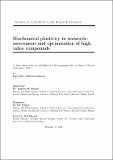| dc.contributor.advisor | Stengel, Dagmar | |
| dc.contributor.author | Schmid, Matthias | |
| dc.date.accessioned | 2016-02-24T12:04:17Z | |
| dc.date.issued | 2016-02-16 | |
| dc.identifier.uri | http://hdl.handle.net/10379/5576 | |
| dc.description.abstract | Macroalgae are important primary producers and habitat forming organisms of the marine coastal zone. In response to different environmental parameters, the chemical composition of macroalage can change as an acclimation mechanism. This results in a strong plasticity in both quantities and composition of different chemical compounds. Many of these compounds have gained interest due to potential beneficial health effects in humans. Different industry sectors have exhibited an increasing interest in algae as a source of these compounds, including pigments and fatty acids. However, the described biochemical plasticity can pose an obstacle for industry because they are often seeking a stable and optimized biomass.
The aim of this study was to assess the natural plasticity of valuable compounds (pigments and fatty acids) and to identify the main abiotic factors causing changes in the biochemical profile of macroalgae. A combination of field-based and laboratory studies were applied to investigate the effects on macroalgae of different taxonomic groups, morphology and habitat (i.e. Ascophyllum nodosum, Fucus serratus, Himanthalia elongata, Laminaria digitata and Palmaria palmata). The assessment of the natural plasticity of pigments and fatty acids in seaweeds included the comparison of macroalgae collected from different seasons and locations as well as investigating variability within the algal thallus.
Results of this study detected that variability of pigments and fatty acids can be caused by taxonomic or ecological differences between species and/or driven by environmental factors. Differences in the seasonal patterns of fatty acid contents were explained by differences in the seasonal remodelling of neutral and polar lipid classes.
Macroalgal response to environmental parameters (temperature and irradiance) was used to optimize the culture conditions for the production of pigments and fatty acids by combining optimal conditions for growth and the production of valuable compounds. This study identified ethanol as suitable food-grade lipid extraction solvent and investigated the stability of valuable compounds in stored algal biomass.
Results of this study highlight the importance of the observed plasticity as an ecophysiological response and give implications on algal response to varying environmental conditions. The identification of seasonal and geographical patterns in levels of fatty acids and pigments provide valuable information to exploit the potential of macroalgae by carefully choosing preferable harvesting times and locations. Information on optimised cultivation conditions can be used to actively alter macroalgae
biomass in controllable aquaculture facilities. | en_IE |
| dc.rights | Attribution-NonCommercial-NoDerivs 3.0 Ireland | |
| dc.rights.uri | https://creativecommons.org/licenses/by-nc-nd/3.0/ie/ | |
| dc.subject | Seaweed | en_IE |
| dc.subject | Bioactive compounds | en_IE |
| dc.subject | Fatty acids | en_IE |
| dc.subject | Pigments | en_IE |
| dc.subject | Omega-3 fatty acids | en_IE |
| dc.subject | Lipids | en_IE |
| dc.subject | Seasonal variability | en_IE |
| dc.subject | Functional foods | en_IE |
| dc.subject | Macroalgae | en_IE |
| dc.subject | Algal cultivation | en_IE |
| dc.title | Biochemical plasticity in seaweeds: assessment and optimisation of high value compounds | en_IE |
| dc.type | Thesis | en_IE |
| dc.contributor.funder | Marine Institute | en_IE |
| dc.contributor.funder | Department of Agriculture, Food and the Marine (NutraMara project) | en_IE |
| dc.local.note | This thesis examined the plasticity in pigments and fatty acids in native Irish seaweeds. Research investigated natural spatial and seasonal variability, and optimisation of compounds in culture. Results highlight important physiological responses of seaweeds to their environment, with implications for utilisation of seaweeds as a source of valuable compounds. | en_IE |
| dc.description.embargo | 2017-02-16 | |
| dc.local.final | Yes | en_IE |
| nui.item.downloads | 772 | |


